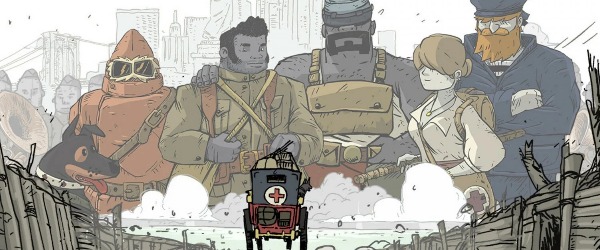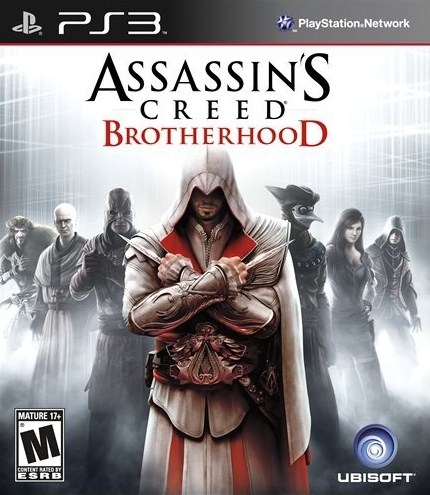
Assassin's Creed: Brotherhood - Review
by Arthur Kabrick , posted on 11 December 2010 / 8,288 ViewsAssassin’s Creed II was perhaps the most enormous leap in the quality of a franchise of the last decade. A repetitive, monotonous trek with thoroughly detestable characters and a poor excuse for a story was transformed into one of the most engaging and enjoyable open-world games of the generation. An improvement of this level is clearly unattainable in the case of Brotherhood, due to the quality of its predecessor, but this game is at least as much fun to play as ACII, if not quite as gripping.
You play once again as modern assassin Desmond Miles, controlling his Renaissance ancestor Ezio Auditore da Firenze, through the Animus. Both story arcs follow on immediately (and I do mean immediately) after the end of Assassin’s Creed II. Desmond’s Animus is located in one of the few remaining Assassin Sanctuaries, and Ezio travels to Rome in order to wipe out the influence of Rodrigo Borgia (Pope Alexander) and his son Cesare, and find the Apple of Eden, aided by a few old friends (who have, in past, not been very heavily featured) and several new Assassin recruits. The story isn’t quite as fleshed out as in ACII, with more focus on the variety of non-story-related content in Rome, far greater in quantity and, for the most part, quality, than in previous games. Desmond plays a much greater role in Brotherhood, but this is mostly limited to the beginning and end of the game, as well as a few emails to be read and trivial conversations with Shaun, Lucy and Rebecca to be experienced if you ever choose to leave the Animus (at only a few points is this obligatory).
Rome, though only a single city, is extremely large, perhaps larger than Venezia and Firenze combined, if one includes the explorable surrounding region. As we have come to expect with this particular franchise, the city is filled with famous landmarks, including the Colosseum, the Rosa in Fiore, and the Pantheon, all of which can be scaled and even purchased. Rome’s streets, like those of Florence and Venice, are walked by a motley collection of guards, civilians, thieves, mercenaries and courtesans, and are lined with stores and banks. However, before the majority of these can be patronised, Ezio will need to spend a few thousand of his precious florins to renovate them, which has the added effect of bringing in some income thrice an hour. Renovation, in turn, requires the destruction of the nearest Borgia Tower. A Borgia Tower is (naturally) a tower controlled by the Borgia, and guarded by a Borgia Captain and his retinue. To free the district, you must kill the captain, evade his guards, climb the tower, and burn it to the ground, at which point it becomes an Assassin Tower and acts as a pigeon coop (more on these later in the review).
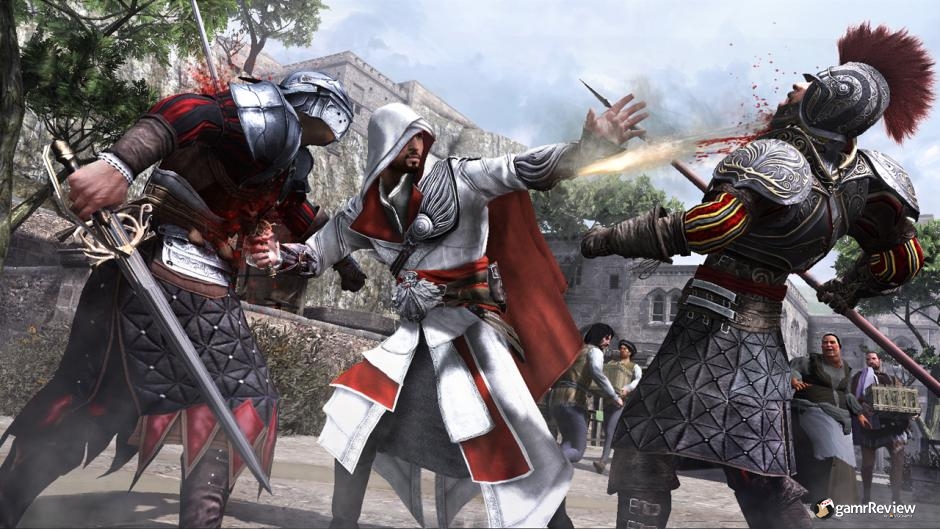
Combat is largely unchanged from Assassin’s Creed II. There are only a handful of significant changes, but these serve to both vastly improve the flow of the combat, and render it laughably easy. The first of these is the ability to kick your enemy, which is indeed significant, because this breaks their guard. Even more significant is the inclusion of permanent double-handed weapons, which are slower but much more powerful than single-handers, and can be smashed on an enemy’s head for an instant kill. The gun is now much more accurate, and takes less time to reload, making it a viable option for killing larger enemies, and is complemented by a crossbow, which has a greater range and more ammunition and, indeed, isn’t really worse than the gun in any way. However, the most important change of all is the implementation of the kill streak. If you execute an enemy, you can one-hit kill every other enemy in the vicinity, and this streak continues until you are hit or you pause for too long. This makes the combat feel much smoother, but also removes the majority of the challenge therein. Without a doubt, Brotherhood is significantly easier than either of its predecessors, and this is one of its main weaknesses.
Probably the largest change to the actual formula of the game is the titular Assassin Brotherhood, a collection of victimised civilians saved by Ezio who slowly, by completing contracts around Europe, grow stronger until they finally become full-blown Assassins. You control the Recruits from a pigeon coop or Assassin Tower, and can upgrade their weapons and armour, send them on contracts, and view contract history. Each destroyed Borgia Tower unlocks one Recruit slot, with ten being the maximum number of recruits. By defeating a few guards and saving a young man or woman’s life, Ezio brings new recruits into the Brotherhood. By completing said contracts, they gain experience and level up, which improves their armour and weaponry. Only at level ten can they be fully initiated as Assassins and take their first Leap of Faith. Each contract is rated out of five for difficulty. Each Recruit assigned to a contract, up to a maximum of five, increases the chance of a contract being completed successfully. The increase in chance depends on the difficulty of the mission and the level of the Recruit. After several minutes, if the contract is completed successfully, the Recruits return with experience, money and occasionally rare items, and can be sent on new contracts, or called in to aid Ezio by assassinating the targeted enemy and helping their master to fight other nearby guards. If the recruits fail, they may well die during the mission and never return, but this most probably will not happen, as long as you err on the side of caution when allocating Recruits to a mission. Calling in all Recruits costs one assassin signal (these recharge, and the maximum is based on the number of available Recruits). Ordering an arrow storm, which kills all guards in Ezio’s line of sight, takes a full three signals. Calling in Recruits can be extremely helpful in difficult stealth or combat situations.
The main story plays a lesser role in Brotherhood than in ACII. There are only nine memory sequences, rather than fourteen. These sequences are again split up into “memories”, which are effectively missions. Most memories have a “Full Synchronisation” objective, a small action which you can perform, to add a small challenge, such as remaining undetected, or killing your target with the hidden blade. The main story is centred around bringing down key allies of the Borgia to weaken their stranglehold on Rome, and is really nowhere near as interesting as that of Assassin’s Creed II, due to a profound lack of interesting and well-developed characters. It is clear that Brotherhood is supposed to be a non-linear game, and the emphasis is on the alternative content involved, most of which still revolves around weakening the Borgia.
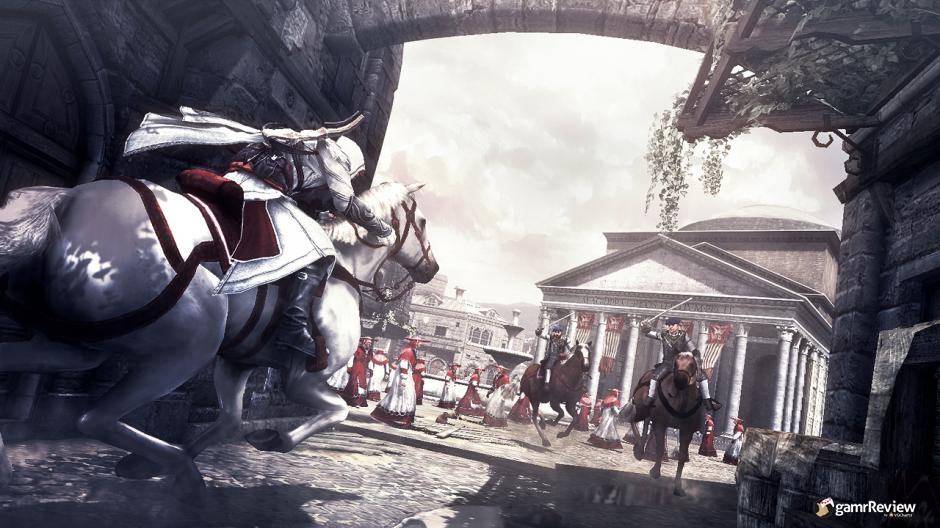
Each of the three guilds from ACII – courtesans, mercenaries and thieves - returns as a faction in Brotherhood. Fairly early on in the game, Ezio needs to win their support by renovating their headquarters, at which point he is initiated into the guild, and can perform assignments or complete challenges to improve his standing. The main effect of this is a discount on courtesan, thief and mercenary services, but since each of these only costs a few hundred florins, and within a few hours, you will be stockpiling tens of thousands of florins, they just end up being a somewhat enjoyable diversion.
Another side-storyline is Leonardo’s Machines. These transport Ezio to a somewhat distant town, where he must evade guards, and destroy the blueprints of a war machine created for Cesare Borgia by Leonardo da Vinci, followed by the machine, on the request of Da Vinci himself. Stealth is key here, and these would be the hardest parts of the game if not for the crossbow, which can kill at a large distance, silently, even while a guard is staring straight at you (being discovered as an assassin results in immediate desynchronisation). Completing all of these gives Ezio the parachute, which he can use to prevent fall damage. While this is not an enormous incentive, this is really the only non-platforming-related challenge you’re going to get in the single-player, and it is definitely the best of the non-story-related content.
As for platforming-related challenges, similar to the Assassin Seals from ACII, you can explore a number of Romulus Lairs, the secret hideouts of a strange race of apparent lycanthropes (or perhaps they’re just furries). This involves, for lack of a better analogy, Uncharted-style platforming, which looks extremely out of place, especially once Ezio begins, like Drake, to talk to himself, but if you ignore the slight discomfort brought about, you have a series of rather difficult platforming segments in a large maze, followed by an enormous room full of treasure. As an aside, the Desmond gameplay is actually very similar to the Romulus Lairs, and the Uncharted similarities are exacerbated by the fact that Nolan North voices both Desmond Miles and Nathan Drake, and thus they sound exactly the same. The Romulus Lairs probably make up the majority of the non-story-related content in Brotherhood, and are almost certainly the most challenging part of the game.
The Cristina Missions make up a short storyline of five memories, in which you play as a young Ezio as he tries to court a young girl. These don’t really involve anything particularly interesting, and finishing them all achieves nothing, so they are no replacement for actual story missions, but they do give Ezio some character development.
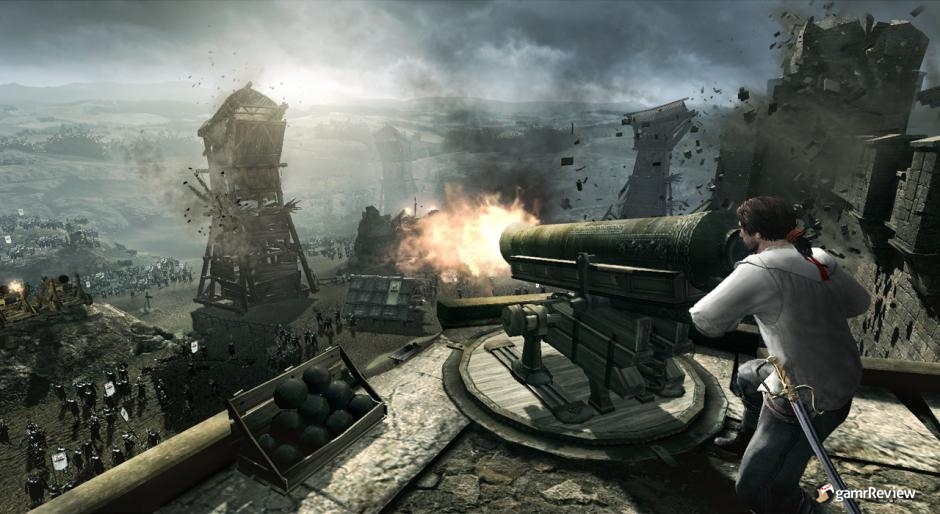
Outside the game itself, you can attempt some virtual training challenges from the pause menu: Free Run, Stealth, Flag Location, and Combat. Gaining a high score on these puts you on a leaderboard with your friends and the rest of the world, and this can be a nice diversion from a particularly frustrating mission, as well as a way to train your assassin skills.
Essentially, Brotherhood attempts to replace story content with a series of diversions. Admittedly, some of these diversions are actually very enjoyable, interesting and well-designed, and they do add variety, but they are no replacement for the fantastic main storyline of Assassin’s Creed II, which contained an enormous amount of variety in itself, and still managed to add in additional content. Certain types of memory in Brotherhood – Borgia Towers, Leonardo Machines and Romulus Lairs – really add to the game, but Cristina Missions and the majority of faction missions just feel like filler, and it is for this reason, along with the weak story, rather than the “lack of gameplay evolution” so often criticised, that Brotherhood’s single-player just isn’t as good as that of ACII.
However, the main addition in this iteration is the multiplayer, and this is actually surprisingly good. You are part of an enormous Templar project to train Templar agents in combat and stealth for the imminent war against the Assassin Order. Immortalised in the Animi are a group of notorious Templars from the Renaissance, most of whom were killed by Ezio. You can play as one of these characters in each of three gameplay modes. In Wanted, you have an assassination target, and you are simultaneously someone else’s target. You must find and kill your target before you find a blade, or a bullet, lodged in your back. A picture of your target is provided, as well as a radar telling you their direction and proximity. There is also Advanced Wanted, but this is really just the same thing, with a less accurate radar. Manhunt puts you into teams of four. One team hunts, and one team hides, and then the teams switch sides. Each person on a certain team looks the same, which can help to find your recent victim’s allies. Alliance is halfway between these two modes: there are three teams of two, and you must hunt one team, and evade one team. This is my personal favourite, as you see more action than in Wanted, and teamwork is required, but it is not quite as crowded and confusing as Manhunt.
The key to the multiplayer is staying hidden. This keeps you out of the sight of your would-be assassin – each level is filled with non-player characters that walk around normally, and sprinting/jumping/climbing show that you are not one of them. If you kill an NPC, your contract is lost and you must wait for a new one. In addition, staying hidden while you kill your target gives you a greater point bonus – Discreet if you just barely avoided being discovered, Silent if you began acting suspicious but then calmed down for the kill, and Incognito if the target never so much as realised that you were there at any point.
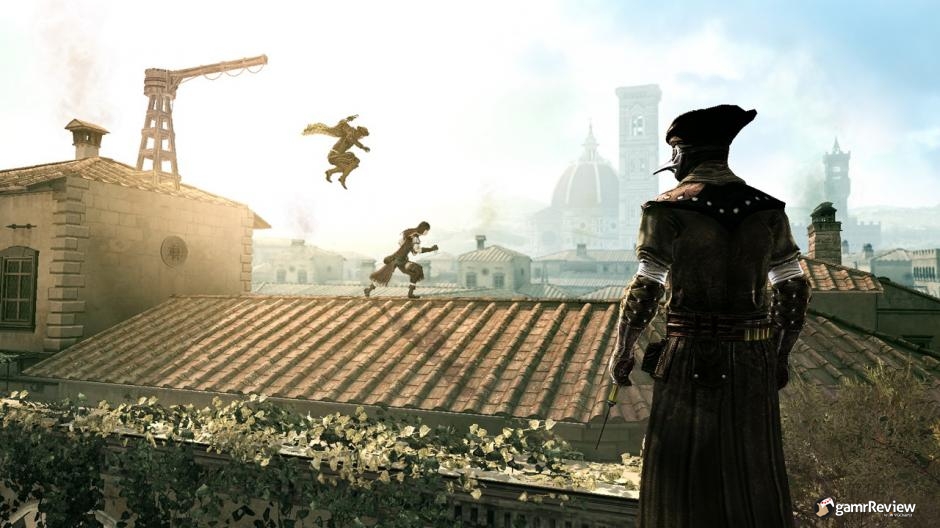
As you perform kills and gain bonuses, you earn experience, which leads to a rise in your level. With each new level comes several unlocks: two special abilities, and two loss streaks, among other things. The level cap is 50, and getting this high will take quite a while. The multiplayer is enjoyable, even if not as enjoyable as the single-player, and adds a huge amount of replay value to Brotherhood.
The graphics are, for the most part, very good. Buildings, environments and characters are all intricately detailed and look fantastic together, as has become standard for the Assassin’s Creed franchise. It does look slightly better than Assassin’s Creed II, but this could just be a psychological effect; it is running on the same engine, which is admittedly not as impressive now as a year ago, and it is unlikely that textures and models would have been tweaked significantly in only one year. However, it does inherit some of ACII's problems. Pop-in is an occasional problem; facial animation, while good, isn't quite up to the standard of the better HD console games, and faces tend to be expressionless; water looks rather primitive, with a lack of realistic ripple and splash effects, but it's not awful. Voice acting is as strong as that of ACII, which is quite obvious, seeing as most of the characters are the same, and music is well-placed and fits the mood.
The main story itself isn’t particularly long, but you will not want to only experience the story. Even if you try, you will be distracted by a plethora of side-missions, stores to renovate, Borgia towers to destroy, and much more. A reasonable playthrough takes around 20 hours, and full completion of the single-player, being much more attainable now and actually an incentive to keep playing, should take around 25. Another few hours of gameplay are certainly added by the multiplayer to make for a very long game indeed.
Unfortunately, at the end of the day, Brotherhood isn’t quite as good as Assassin’s Creed II, but the standard set by its predecessor was so high that this doesn’t mean it’s not a fantastic game. Even if the story, characters and difficulty leave something to be desired and some of the content is filler, the variety is staggering, the majority of the gameplay is brilliant, and the core gameplay has improved, if only slightly, with the addition of new weapons and the Assassin Recruits. The multiplayer is an interesting take on the main game and actually works very well. A game developed in just a year, to follow on from an extremely successful and well-loved game, runs the risk of being branded a cash-in, but Brotherhood is certainly not. This is not franchise-milking, and nor is it a spin-off. Brotherhood is an Assassin’s Creed game down to the core, and although ACII is a superior game, Brotherhood is an enthralling, enjoyable and varied experience.
VGChartz Verdict
8.8
Great









